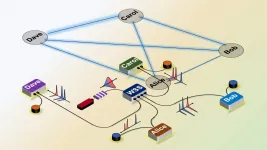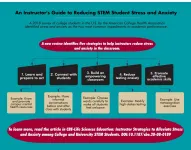(Press-News.org) WEST LAFAYETTE, Ind. -- When quantum computers become more powerful and widespread, they will need a robust quantum internet to communicate.
Purdue University engineers have addressed an issue barring the development of quantum networks that are big enough to reliably support more than a handful of users.
The method, demonstrated in a paper published in Optica, could help lay the groundwork for when a large number of quantum computers, quantum sensors and other quantum technology are ready to go online and communicate with each other.
The team deployed a programmable switch to adjust how much data goes to each user by selecting and redirecting wavelengths of light carrying the different data channels, making it possible to increase the number of users without adding to photon loss as the network gets bigger.
If photons are lost, quantum information is lost - a problem that tends to happen the farther photons have to travel through fiber optic networks.
"We show a way to do wavelength routing with just one piece of equipment - a wavelength-selective switch - to, in principle, build a network of 12 to 20 users, maybe even more," said Andrew Weiner, Purdue's Scifres Family Distinguished Professor of Electrical and Computer Engineering. "Previous approaches have required physically interchanging dozens of fixed optical filters tuned to individual wavelengths, which made the ability to adjust connections between users not practically viable and photon loss more likely."
Instead of needing to add these filters each time that a new user joins the network, engineers could just program the wavelength-selective switch to direct data-carrying wavelengths over to each new user - reducing operational and maintenance costs as well as making a quantum internet more efficient.
The wavelength-selective switch also can be programmed to adjust bandwidth according to a user's needs, which has not been possible with fixed optical filters. Some users may be using applications that require more bandwidth than others, similarly to how watching shows through a web-based streaming service uses more bandwidth than sending an email.
For a quantum internet, forming connections between users and adjusting bandwidth means distributing entanglement, the ability of photons to maintain a fixed quantum mechanical relationship with one another no matter how far apart they may be to connect users in a network. Entanglement plays a key role in quantum computing and quantum information processing.
"When people talk about a quantum internet, it's this idea of generating entanglement remotely between two different stations, such as between quantum computers," said Navin Lingaraju, a Purdue Ph.D. student in electrical and computer engineering. "Our method changes the rate at which entangled photons are shared between different users. These entangled photons might be used as a resource to entangle quantum computers or quantum sensors at the two different stations."
Purdue researchers performed the study in collaboration with Joseph Lukens, a research scientist at Oak Ridge National Laboratory. The wavelength-selective switch that the team deployed is based on similar technology used for adjusting bandwidth for today's classical communication.
The switch also is capable of using a "flex grid," like classical lightwave communications now uses, to partition bandwidth to users at a variety of wavelengths and locations rather than being restricted to a series of fixed wavelengths, each of which would have a fixed bandwidth or information carrying capacity at fixed locations.
"For the first time, we are trying to take something sort of inspired by these classical communications concepts using comparable equipment to point out the potential advantages it has for quantum networks," Weiner said.
The team is working on building larger networks using the wavelength-selective switch. The work was funded by the U.S. Department of Energy, the National Science Foundation and Oak Ridge National Laboratory.
INFORMATION:
ABSTRACT
Adaptive bandwidth management for entanglement distribution in quantum networks
Navin B. Lingaraju, Hsuan-Hao Lu, Suparna Seshadri, Daniel E. Leaird, Andrew M. Weiner, Joseph M. Lukens
DOI: 10.1364/OPTICA.413657
Flexible-grid wavelength-division multiplexing is a powerful tool in lightwave communications for maximizing spectral efficiency. In the emerging field of quantum networking, the need for effective resource provisioning is particularly acute, given the generally lower power levels, higher sensitivity to loss, and inapplicability of optical detection and retransmission. In this Letter, we leverage flex-grid technology to demonstrate reconfigurable distribution of quantum entanglement in a four-user tabletop network. By adaptively partitioning bandwidth with a single wavelength-selective switch, we successfully equalize two-party coincidence rates that initially differ by over two orders of magnitude. Our scalable approach introduces loss that is fixed with the number of users, offering a practical path for the establishment and management of quality-of service guarantees in large quantum networks.
Scientists regularly use remote sensing drones and satellites to record how climate change affects permafrost thaw rates -- methods that work well in barren tundra landscapes where there's nothing to obstruct the view.
But in boreal regions, which harbor a significant portion of the world's permafrost, obscuring vegetation can stymy even the most advanced remote sensing technology.
In a study published in January, researchers in Germany and at the University of Alaska Fairbanks' Geophysical Institute developed a method of using satellite imagery to measure the depth of thaw directly above permafrost in boreal ecosystems. Rather than trying to peer past ...
They can hear well up to about forty years old, but then suddenly deafness strikes people with DFNA9. The cells of the inner ear can no longer reverse the damage caused by a genetic defect in their DNA. Researchers at Radboud university medical center have now developed a "genetic patch" for this type of hereditary deafness, with which they can eliminate the problems in the hearing cells. Further research in animals and humans is needed to bring the genetic patch to the clinic as a therapy.
Hereditary deafness can manifest itself in different ways. Often the hereditary defect (mutation) immediately causes deafness from birth. Sometimes, as with DFNA9, you experience the initial ...
Philadelphia, March 2, 2021--Taking the first deep dive into how the immune system is behaving in patients with multisystem inflammatory syndrome in children (MIS-C), researchers at Children's Hospital of Philadelphia (CHOP) and the Perelman School of Medicine at the University of Pennsylvania have found that children with this condition have highly activated immune systems that, in many ways, are more similar to those of adults with severe COVID-19. The results, published today in Science Immunology, show that better understanding the immune activation in patients with MIS-C could not only help better treat those patients but also improve treatment for adults with ...
A new study of patients with Multisystem Inflammatory Syndrome in Children (MIS-C), a rare but severe complication of COVID-19 in children, reveals distinct immune features of COVID-19 not seen in adults that may clue scientists in to why SARS-CoV-2 infection manifests differently in children compared with adults. Their results showed that although the immune landscape in pediatric COVID-19 was similar to that in adults, MIS-C patients uniquely exhibited increased activation of a blood vessel-patrolling CD8+ killer T cell subset, and all pediatric COVID-19 patients harbored greater B cell frequencies for a more prolonged period of time than observed in healthy adults. MIS-C is characterized by pervasive inflammation, an array of symptoms ranging from fever ...
Orange, Calif. - Even before the COVID-19 pandemic, college students were reporting record levels of stress and anxiety. According to the American College Health Association END ...
The Deepwater Horizon disaster began on April 20, 2010 with an explosion on a BP-operated oil drilling rig in the Gulf of Mexico that killed 11 workers. Almost immediately, oil began spilling into the waters of the gulf, an environmental calamity that took months to bring under control, but not before it became the largest oil spill in the history of the petroleum industry.
Nearly 10 years have passed since then, and the oil slick has long since dispersed. Yet, despite early predictions, area wildlife are still feeling the effects of that oil, and research published in Environmental Toxicology and Chemistry has shown that negative health impacts have befallen not only dolphins alive at the time of the spill, but also in their young, born years later.
A team of researchers, including ...
When central nervous system cells in the brain and spine are damaged by disease or injury, they fail to regenerate, limiting the body's ability to recover. In contrast, peripheral nerve cells that serve most other areas of the body are more able to regenerate. Scientists for decades have searched for molecular clues as to why axons -- the threadlike projections which allow communication between central nervous system cells -- cannot repair themselves after stroke, spinal cord damage, or traumatic brain injuries.
In a massive screen of 400 mouse genes, Yale School of Medicine ...
Disruptions in the circadian rhythms in lung cells may explain why adults who survived premature birth are often more at risk of severe influenza infections, suggests a study in mice published today in eLife.
Dramatic improvements in the care of infants born prematurely have allowed many more to survive into adulthood. Yet ex-preemies can face several long-term side effects of the life-saving care they received. The study suggests potential new approaches to treating lasting lung problems in those born prematurely.
Many premature infants are not able to breathe on their own and require oxygen to survive. ...
College course syllabi written in a warm, friendly tone are more likely to encourage students to reach out when they are struggling or need help, a new study from Oregon State University found.
Conversely, when a syllabus is written in a more cold, detached tone, students are less likely to reach out.
The study also compared the effect of syllabus tone with the effect of a deliberate "Reach out for help" statement included in the document.
"The instructor has to ask themselves, what's the first point of contact with the class for the student? In an online class and in remote learning, the syllabus is often the ...
The United States experiences more tornadoes than any other country, with a season that peaks in spring or summer depending on the region. Tornadoes are often deadly, especially in places where buildings can't withstand high winds.
Accurate advanced warnings can save lives. A study from the University of Washington and the National Oceanic and Atmospheric Administration describes a new way to rate and possibly improve tornado warnings. It finds that nighttime twisters, summer tornadoes and smaller events remain the biggest challenges for the forecasting community.
"This new method lets us measure how forecast skill is improving, decreasing or staying the same in different situations," said Alex ...



